Keywords |
| Congestion Relief Charge, Demand Side Management, Supply Side Management, Congestion Relief
Management, Ancillary Market (AM). |
INTRODUCTION |
| Congestion Relief Management is the process to avoid or relieve the congestion in the transmission system which
includes the computation of Congestion Relief Charge (CRC) and Total Contract Violation (TCV) [1]. But in the
deregulation, congestion has become a term in conjunction with power systems and competition [3]. The amount of
electric power that can be transmitted between two locations through a transmission network is limited by security
constraints. Power flows should not be allowed to increase a limit at which the network to collapse due to angular
instability, voltage instability or cascaded outages. The system is said to be congested when such a limit is reached [2].
Various congestion management schemes suitable for different electricity market structure have been reported in the
literature [4]. |
| When the congestion happens, Independent System Operator (ISO) will be fully responsible for the operation of
Ancillary Service Market (ASM) to manage supply and demand sides [6]. Congestion Relief Charge functions, Total
Contract Violations etc. have been derived and to get back profit in the system. Independent System Operator can
allocate the payments to the participants in proportion to the usage of the system [7]. |
| However, from the literature, all the above analysis has been carried out with real power constraints only, with no
changes in reactive powers. In this paper, reactive power constraint with no change in real power is considered. Further,
the combination of the real and reactive power changes keeping the other unchanged are simultaneously considered and
used as a constraint for complex power to obtain Minimum CRC, Minimum Total Contract Violation (TCV), and
Minimum Compromised Objective Function (COF). Further, three cases are also considered Viz., Supply Side
Management (SSM), Supply Side and Interruptible Load Management (SS&ILM), Supply Side and Demand Side
Management (SS & DSM). |
| In Section II, the mathematical model and algorithm for the proposed method are presented. In Section III, the
description on a case study i.e., 6 bus test system is presented. In Section IV, the simulation results and analysis are
presented. In Section V, the conclusions are presented. |
MATHEMATICAL MODELS FOR PROPOSED METHOD |
| The procedure for congestion relief management considering both reactive and complex power constraints is presented
in this section. |
A. Congestion Relief with Reactive Power Constraints |
| The reactive power constraints can be included in the objective function for Congestion Relief Charge: |
 |
| Subjected to: |
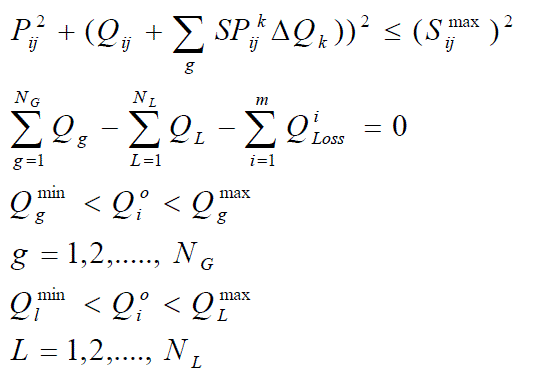 |
| Where, |
| G N Number of supply side to participate in congestion relief |
| L N Number of demand side to participate in congestion relief |
| ij S MVA flow limit of a congested line between bus-i and bus-j |
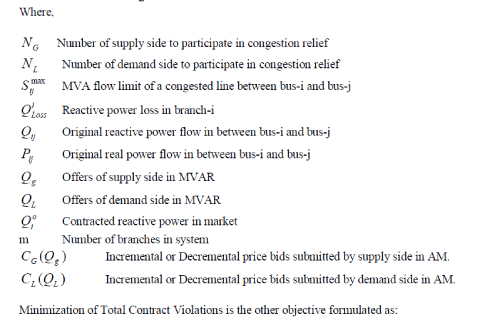 |
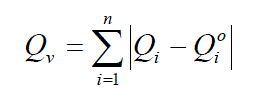 |
| Subjected to: |
 |
| By combining above two Eqns. (1) and (2), the Compromised Objective Function (COF) is formulated, to satisfy the
objectives of the ISO, i.e, minimize Total Contract Violation (TCV) as well as total payment paid as CRC [2, 7]. |
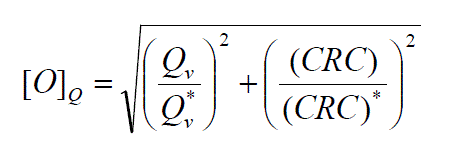 |
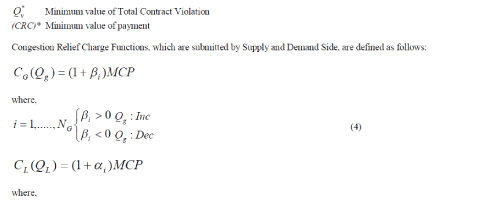 |
 |
| To relieve the congestion in the system, huge amount of money is needed. The total expenses for relieving the
congestion on the system are to be paid by the system participants. To get back this cost including profit, the ISO can
allocate the payments to the participants in proportion of the participant's usage of system and is treated as Market
Clearing Price (MCP) [7]. This is formulated with reactive power constraints as: |
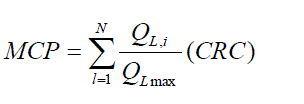 |
| N Number of congested line |
| QLi Power flow in MVAR on line L allocated to participant i |
| Q LmaxMax power flow in MVAR on line L. |
Algorithm: |
| 1. Read the input data i.e., branch data, bus data. |
| 2. Run the AC optimal power flow and compute the values of β and α . |
| 3. Compute MCP using Eqn. (5). |
| 4. Consider the cases of supply side management, supply side & interruptible load management and supply side
& demand side management for congestion relief. |
| 5. Compute CRC, TCV and COF using Eqns. (1), (2) and (3) for the above cases. |
| 6. Stop. |
B. Congestion Relief with Complex Power Constraints |
| The Complex power constraints can be included in the objective function for Congestion Relief Charge: |
 |
| Subjected to: |
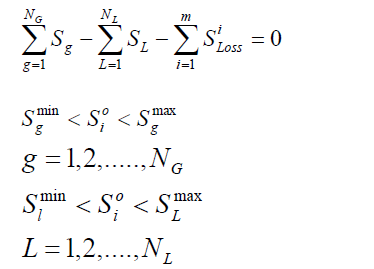 |
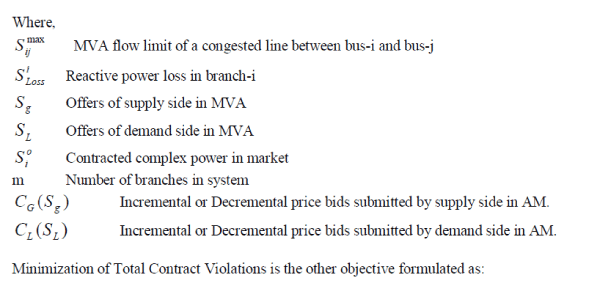 |
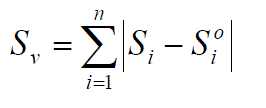 |
| Subjected to: |
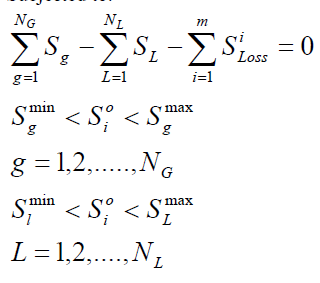 |
| To satisfy the objectives of ISO, the COF is formulated by combining equations (6) and (7) as |
 |
| Where, |
| Sv * Minimum value of Total Contract Violation |
| (CRC)* Minimum value of payment |
| Congestion Relief Charge Functions, which are submitted by Supply and Demand Side, are defined as follows: |
 |
 |
| As in the case of reactive power, ISO can allocate the payment to the participants in proportion of the participant’s
usage of the system. Similarly, with respect to complex power, the payment allocation by ISO is formulated as: |
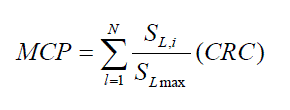 |
| Where, |
| N Number of congested line |
| S Li Power flow in MVA on line L allocated to participant i |
| S Lmax Max power flow in MVA on line L. |
CASE STUDY |
| In this paper, a sample 6 bus system [5] shown in Fig. 1 is used as a case study to illustrate the CRM methodology with
respect to reactive and apparent powers |
| To analyse the CRM using 6 bus system, three different cases [3] have been used in this paper and are known as: |
| 1. Supply Side Management (SSM) |
| 2. Supply Side and Interruptible Load Management (SS&ILM) |
| 3. Supply Side and Demand Side Management (SS & DSM) |
| With the above three cases, in the paper [3] only real power congestion management is used, where as in this paper,
reactive power and complex power congestion managements are also obtained and results are compared. |
SIMULATION RESULTS |
| The simulation results obtained from the MATLAB program are presented in this section. From the branch report
obtained using OPF [5], it is observed that the line limit for line 5 (connected between buses 2 and 4) has exceeded the
maximum limit i.e., 114.4%. After CRM process with minimised relief costs, the line limit is within the limits i.e.
99.01%. |
| The simulation results of CRM for three cases with respect to real power are presented in Table I. |
| The simulation results of CRM for three cases with respect to reactive power are presented in Table II. |
| The simulation results of CRM for three cases with respect to complex power are presented in Table III. |
| The graphical representation of the objective function in case of real power is shown in the below Fig. 2. |
| The graphical representation of the objective function in case of reactive power is shown in the below Fig. 3. |
| The graphical representation of the objective function in case of complex power is shown in the below Fig. 4. |
| From the above results, it can be seen that the minimum cost and minimum power violation required for the CRM to
maintain the line 5 limit within the max limit i.e., 100%. From Table I, it is observed that, the value of CRC is less in
the case 3 i.e., Rs. 1.80. Similarly, the value of TCV is also less in case 3. Hence, it is concluded that, case 3 provides
the optimum and minimum cost for CRM and minimum power violations with respect to real power among all the
cases. |
| But, in the case of reactive power, the case 2 provides the minimum cost for CRM and similarly in the case of complex
power also. |
CONCLUSIONS |
| The CRM analysis using different cases is investigated in this paper. The CRM methodology is illustrated using 6 bus
system and a MATLAB program has been developed. |
| From the results it is concluded that, the system can relieve the congestion at minimum cost and minimum power
violation with respect to real power by including Supply Side Management and Demand Side Management. |
| The Supply Side and Interruptible Load Management system provides the minimum cost and power violation with
respect to reactive and complex powers. |
Tables at a glance |
|
|
Figures at a glance |
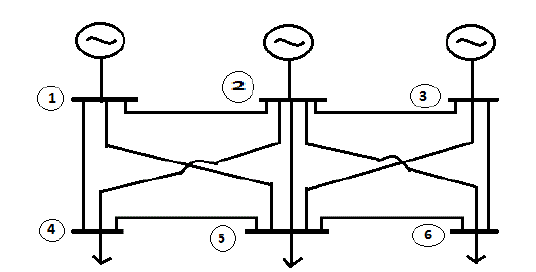 |
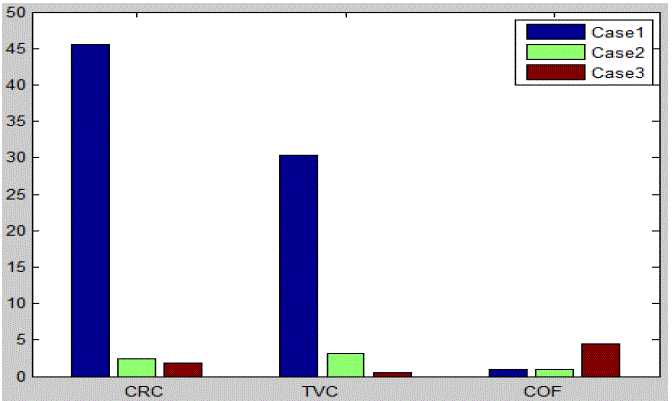 |
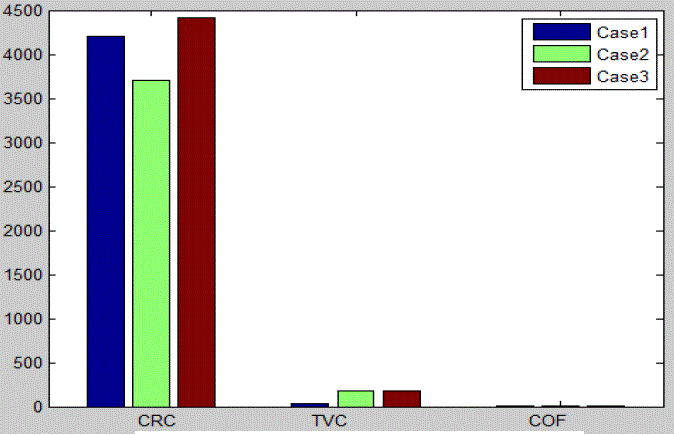 |
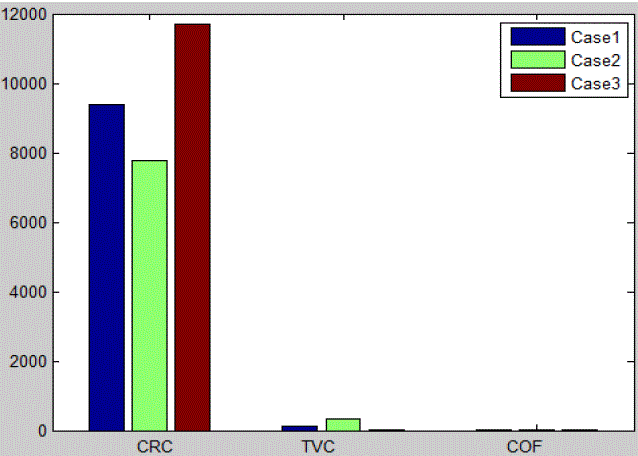 |
| Figure 1 |
Figure 2 |
Figure 3 |
Figure 4 |
|
References |
- Smt.UshaSurendra&S.S.Parathasarthy, “Congestion management in deregulated power sector using fuzzy based optimal location technique for series flexible alternative current transmission system (FACTS) device”, Journal of Electrical and Electronics Engineering Research Vol. 4, No. 1, pp. 12-20, August 2012.
- Deependra Singh and K. S. Verma, “GA-based Congestion Management in Deregulated Power System using FACTS Devices”, IEEE, 2012.
- Mohamad H. Moradi, SomayehDehghan and Hamid R. Faridi, “Improving Zonal Congestion Relif Management Using Economical andTechnical Factors of the Demand side”, second IEEE International Conference on Power and Energy, pp. 1027-1032, Dec. 2008.
- A Kumar, S. C. Srivastava, and S. N. Singh, “A Zonal Congestion Management Approach Using Real and Reactive Power Rescheduling”, IEEE Trans. on Power Systems, Vol. 19, No. 1, February 2004 , pp. 554-561.
- Allen J. Wood and Bruce F. Wollenberg, “Power Generation Operation and Control”, 2nd edition, John Wiley & Sons, 2004.
- Le Anh Tuan and KankarBhttacharya, “Interruptable Load Services for Transmission Congestion Relief”, 14th PSCC, Sevilla, June 2002.
- BaranMesut.E, BanunarayananVenkat, E. Garren Kenneth, “Equitable Allocation of Congestion Relief Cost to transactions, IEEE Trans. On Power Systems”, Vol. 15, No. 2, pp. 579-585, MAY 2000.
|